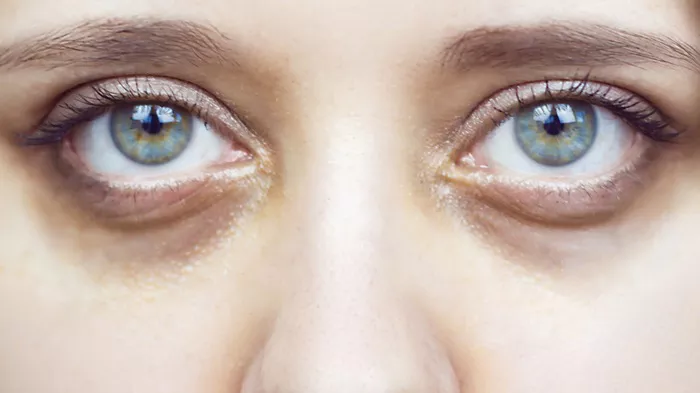Dark circles under the eyes are a common cosmetic concern for many people, often associated with fatigue, aging, or genetics. However, one significant and often overlooked cause of dark circles is allergies. This article explores the various types of allergies that can contribute to the development of dark circles under the eyes, the mechanisms behind this phenomenon, and potential treatments and preventive measures.
What Are Dark Circles Under the Eyes?
Definition and Appearance
Dark circles, also known as periorbital hyperpigmentation, are characterized by the darkening of the skin around the eyes. This condition can manifest as blue, purple, brown, or black discoloration, depending on the individual’s skin tone and the underlying cause. Dark circles can affect anyone, regardless of age or gender, and are often more noticeable in people with lighter skin.
Common Causes
While dark circles can result from various factors, including genetic predisposition, lack of sleep, aging, and lifestyle choices, allergies are a significant but frequently under-recognized contributor. Understanding how allergies cause dark circles requires a closer look at the body’s allergic response and its impact on the delicate skin around the eyes.
The Connection Between Allergies and Dark Circles
Allergic Shiners
The term “allergic shiners” refers to dark circles caused by allergies. These are typically blue or purple and are the result of nasal congestion and sinus inflammation. When the nasal passages are congested, blood flow slows in the veins that drain from the eyes to the nose, leading to pooling of blood and the formation of dark circles.
The Mechanisms Behind Allergic Shiners
Allergic reactions trigger the release of histamines, which cause blood vessels to dilate and increase blood flow to the affected area. In the case of nasal allergies, this leads to congestion and swelling in the nasal passages. The congestion impedes the normal flow of blood from the veins around the eyes, causing blood to pool and the appearance of dark, swollen circles under the eyes.
Types of Allergies That Cause Dark Circles
1. Seasonal Allergies
Seasonal allergies, also known as hay fever or allergic rhinitis, are caused by airborne allergens such as pollen from trees, grasses, and weeds. These allergens trigger an immune response in susceptible individuals, leading to symptoms such as sneezing, runny nose, itchy eyes, and nasal congestion. The congestion and inflammation associated with seasonal allergies can contribute to the formation of dark circles under the eyes.
2. Perennial Allergies
Perennial allergies are similar to seasonal allergies but occur year-round. They are typically caused by indoor allergens such as dust mites, pet dander, mold, and cockroach droppings. Like seasonal allergies, perennial allergies cause nasal congestion and inflammation, leading to dark circles under the eyes.
3. Food Allergies
Food allergies can also contribute to the development of dark circles. Common food allergens include milk, eggs, peanuts, tree nuts, soy, wheat, fish, and shellfish. When an individual with a food allergy consumes the offending food, their immune system reacts by releasing histamines and other chemicals, which can cause swelling, congestion, and dark circles.
4. Contact Allergies
Contact allergies, or allergic contact dermatitis, occur when the skin comes into contact with an allergen, such as certain cosmetics, skincare products, or metals like nickel. The resulting allergic reaction can cause inflammation and discoloration of the skin around the eyes, contributing to dark circles.
5. Atopic Dermatitis
Atopic dermatitis, commonly known as eczema, is a chronic inflammatory skin condition that often affects the face and areas around the eyes. Individuals with atopic dermatitis may experience flare-ups triggered by allergens or irritants, leading to redness, swelling, and dark circles.
Identifying Allergy-Related Dark Circles
Symptoms of Allergy-Related Dark Circles
Dark circles caused by allergies often come with other allergy symptoms, such as:
1. Itchy, watery, or red eyes
2. Nasal congestion or runny nose
3. Sneezing
4. Postnasal drip
5. Swelling around the eyes
Diagnostic Methods
To determine whether dark circles are caused by allergies, healthcare providers may use several diagnostic methods:
Patient History: Discussing the patient’s symptoms, family history, and exposure to potential allergens.
Physical Examination: Observing the appearance of dark circles and other signs of allergic reactions.
Allergy Testing: Conducting skin prick tests or blood tests (such as specific IgE testing) to identify specific allergens.
Managing Allergy-Related Dark Circles
Avoidance of Allergens
The first step in managing allergy-related dark circles is to identify and avoid the allergens that trigger symptoms. This may involve:
1. Using air purifiers and keeping windows closed during high pollen seasons.
2. Regularly cleaning and vacuuming to reduce dust mites and pet dander.
3. Using hypoallergenic bedding and covers to minimize exposure to dust mites.
4. Avoiding foods that trigger allergic reactions.
Medications
Medications can help manage allergy symptoms and reduce the appearance of dark circles. Common options include:
Antihistamines: Over-the-counter or prescription antihistamines can relieve itching, sneezing, and nasal congestion.
Nasal Corticosteroids: These sprays reduce inflammation in the nasal passages and improve breathing.
Decongestants: Oral or nasal decongestants can relieve nasal congestion, though they should be used with caution to avoid rebound congestion.
Topical Corticosteroids: For contact dermatitis and eczema, topical corticosteroids can reduce inflammation and improve skin appearance.
Skincare and Home Remedies
Proper skincare and home remedies can also help alleviate dark circles:
Cold Compresses: Applying a cold compress to the eyes can reduce swelling and constrict blood vessels.
Moisturizers: Using a moisturizer, especially those containing ingredients like hyaluronic acid and ceramides, can improve skin hydration and barrier function.
Adequate Sleep: Ensuring sufficient sleep can help reduce the appearance of dark circles.
Elevating the Head: Sleeping with the head elevated can prevent fluid from accumulating around the eyes.
Medical Treatments
For persistent dark circles, medical treatments may be considered:
Chemical Peels: These can improve skin texture and tone by removing the top layers of damaged skin.
Laser Therapy: Laser treatments can reduce pigmentation and improve skin appearance by stimulating collagen production.
Fillers: Injectable fillers can address volume loss under the eyes, reducing the shadowing that contributes to dark circles.
Preventive Measures
Allergy Management
Preventing allergy-related dark circles involves proactive allergy management:
Allergen Avoidance: Minimize exposure to known allergens through environmental controls and lifestyle adjustments.
Regular Medication Use: Adhere to prescribed allergy medications to keep symptoms under control.
Monitoring Allergens: Stay informed about local pollen counts and allergen levels to anticipate and manage symptoms.
Healthy Lifestyle Choices
Adopting a healthy lifestyle can also help prevent dark circles:
Balanced Diet: Eating a nutritious diet rich in vitamins and antioxidants supports overall skin health.
Hydration: Staying well-hydrated helps maintain skin elasticity and reduces puffiness.
Regular Exercise: Physical activity can improve circulation and reduce inflammation.
Stress Management: Reducing stress through relaxation techniques, such as yoga and meditation, can improve sleep quality and skin appearance.
Skincare Routine
Establishing a consistent skincare routine can help maintain healthy skin around the eyes:
Gentle Cleansing: Use a mild cleanser to remove makeup and impurities without irritating the skin.
Sun Protection: Apply sunscreen to protect the delicate skin around the eyes from UV damage.
Eye Creams: Use eye creams formulated with ingredients like retinol, vitamin C, and peptides to address pigmentation and fine lines.
Conclusion
Dark circles under the eyes can be more than just a cosmetic concern; they can be indicative of underlying allergies. Recognizing the various types of allergies that contribute to dark circles, understanding the mechanisms behind this phenomenon, and implementing effective management strategies are crucial for alleviating this condition. By adopting a comprehensive approach that includes allergen avoidance, medication, skincare, and lifestyle adjustments, individuals can significantly reduce the appearance of dark circles and improve their overall well-being. Consulting with healthcare providers for accurate diagnosis and ongoing management is essential for achieving the best outcomes.
[inline_related_posts title=”You Might Be Interested In” title_align=”left” style=”list” number=”6″ align=”none” ids=”9710,9645,9641″ by=”categories” orderby=”rand” order=”DESC” hide_thumb=”no” thumb_right=”no” views=”no” date=”yes” grid_columns=”2″ post_type=”” tax=””]































